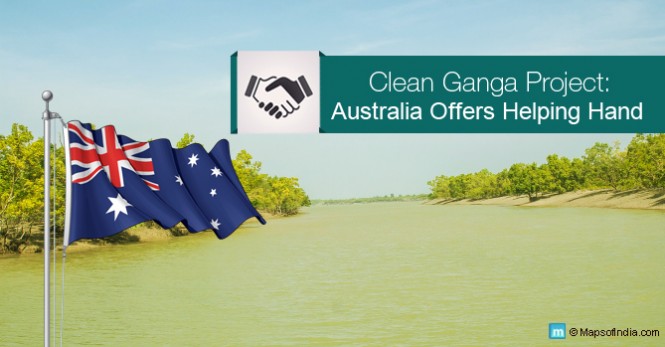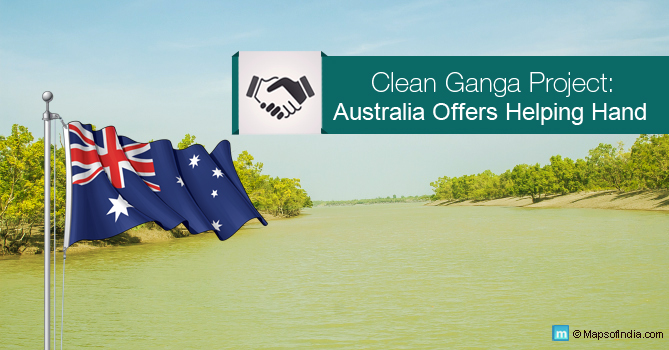 Australia has become the latest country to promise India that it will provide complete technology-related assistance for the ambitious Clean Ganga project. It has stated that procedures such as controlling of effluent discharge could play a major role in this regard. Julie Bishop, the Australian Minister for Foreign Affairs, has had a meeting with Uma Bharti, where she has conveyed this pledge on behalf of her country’s government. Bishop has expressed that Australia will feel delighted to provide any possible technological support for cleaning up the huge river. According to Bishop, Australia has come up with a scorecard that can measure the effluent being discharged into rivers and, thus, also control the same.
Australia has become the latest country to promise India that it will provide complete technology-related assistance for the ambitious Clean Ganga project. It has stated that procedures such as controlling of effluent discharge could play a major role in this regard. Julie Bishop, the Australian Minister for Foreign Affairs, has had a meeting with Uma Bharti, where she has conveyed this pledge on behalf of her country’s government. Bishop has expressed that Australia will feel delighted to provide any possible technological support for cleaning up the huge river. According to Bishop, Australia has come up with a scorecard that can measure the effluent being discharged into rivers and, thus, also control the same.
Australia Assures Complete Technological Help for Clean Ganga
The Minister of Foreign Affairs, Australia, feels that the said score card will be fairly useful for India as well. Uma Bharti feels the same too. The Union Minister for Water Resources, River Development and Ganga Rejuvenation feels that with the scorecard the government will be able to institute certain norms that could be followed by the industries that have been polluting the river. The two ministers also discussed areas where both the countries could further collaborate. Some of them may be mentioned as below:
• Water-flow forecasting
• Groundwater storage mapping
• Recharging groundwater
• Rivers’ interlinking
Indian Government Focuses on Ganga with Pessimistic Report on Yamuna
The Central Pollution Control Board (CPCB) has ruled that Yamuna is very much a dead river. This has coincided with the added focus being put on Ganga by the national government and the relative ignorance granted to Yamuna, which is in a critical condition in Delhi. In fact, Yamuna is not the only river to be in a sordid condition. There are plenty of rivers across India that are in a similar condition – suffering from years of industrial and urban waste being dumped into them.
Shashi Shekhar, who is the Chairman of the CPCB as well as special secretary of the Environment Ministry, says that the increasing rate at which untreated sewage is being deposited in the rivers has contributed to the pollution in the same. A three-year study had been undertaken across 290 rivers by the said board and it is seen that almost 2/3rd of the areas covered have high levels of organic pollution. This is computed by using biological oxygen demand.
The CPCB report further says that thanks to the unchecked pollution many ecosystems in the terrestrial, coastal and aquatic zones have become less productive. The worsening standard and amount of water has also hampered the biodiversity in these areas. Statistically, 8400 km of river water is highly polluted right now and cannot be inhabited by any aquatic life form. The report has further pointed fingers at 370 cities and important towns as the main culprits when it comes to the burgeoning levels of pollution in the rivers. At present India can only treat 30% of the waste it is generating.
In case of Yamuna, it is dying slowly because of the pollution taking place when it passes through Haryana and Uttar Pradesh. Haryana can be credited for initiating the river’s contamination and Delhi carries it on like an effective middle order batsman. In Uttar Pradesh one can hardly see the river and this is where it becomes one with Ganga at Allahabad. In Mumbai, the stretch of Mithi passing between Dharavi and Powal is highly polluted as well. Hindon gets plenty of untreated industrial waste in the phase between Ghaziabad and Saharanpur. Sabarmati, Umkhrah in Shillong and Gaggar in Punjab are also highly polluted rivers according to the CPCB.
The board also doubts if there is any river that is entirely clean. It has also apportioned the blame for burgeoning pollution in the recent years to the municipal bodies which, it states, do not have any plan for dealing with the said waste. At present India accounts for 5% of the global population but only 2% of the freshwater sources. This implies that there is not enough water to be used for purposes of irrigation and drinking. At present India generates 38,000 million tons of waste water a day and the CPCB report says that if the wastewater treatment capacity cannot be increased then there could be some serious consequences in the future.
Read More : Programmes Launched by Modi
Pradhan Mantri Jeevan Jyoti Bima Yojana (PMJJBY)
Pradhan Mantri Suraksha Bima Yojana (PMSBY)
Atal Pension Yojana
MUDRA Bank Yojana
Garib Kalyan Yojnaye
Sukanya Samriddhi Yojana
Beti Bachao, Beti Padhao Scheme
Pahal Scheme
Jan Dhan Yojana




